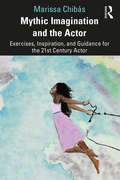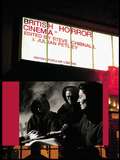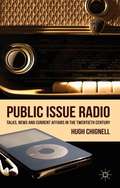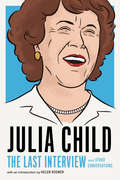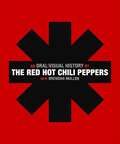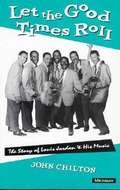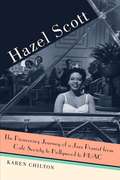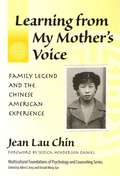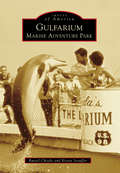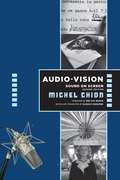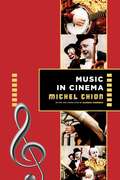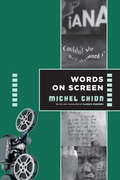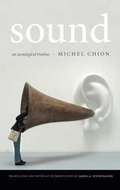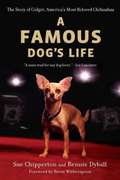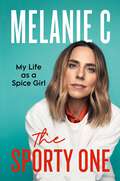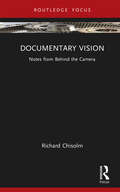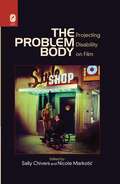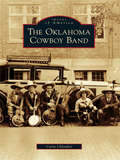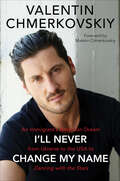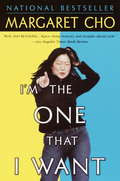- Table View
- List View
Conjugal Relationships in Chinese Culture: Sino-Western Discourses and Aesthetics on Marriage (Chinese Culture #7)
by Chi Sum Garfield Lau Kelly Kar Yue ChanThis book reviews the presentation of conjugal relationships in Chinese culture and their perception in the West. It explores the ways in which the act of marriage is represented/misrepresented in different literary genres, as well as in cultural adaptations. It looks at the gendered characteristics at play that affect conjugal relationships in Chinese societal practices more widely. It also distinguishes between the essential features that give rise to nuptial arrangements from the Chinese perspective, looking at what in which Sino and/or Western mentalities differ in terms of notions of autonomy in marriage. It excavates the extent to which marriage is constituted in forms of transaction between female and male bodies and asks under what circumstances wedding ceremonies constitute archetypal or counter-archetypal notions in pre-modern and modern society. Authors cover a range of fascinating cultural topics, such as posthumous marriage (necrogamy) as an ancient and popular folk culture from the perspective of Confucian ideology, as well as looking at marriage from ancient to present times, duty and rights in conjugal relations, inter-racial and inter-cultural marriage, widowhood in Confucian ideology, issues of legitimacy in marriage and concubinage, the taboos surrounding divorce and re-marriage, and conjugal violence. The book serves to revisit the cultural connections between marriage and various art forms, including literature, film, theatre, and other adaptations. It is a rich intellectual resource for scholars and students researching the historical roots, cultural interpretations, and evolving aspects of marriage as shown in literature, art, and culture.
Mythic Imagination and the Actor: Exercises, Inspiration, and Guidance for the 21st Century Actor
by Marissa ChibásIn Mythic Imagination and the Actor, Marissa Chibás draws on over three decades of experience as a Latinx actor, writer, filmmaker, and teacher to offer an approach to acting that embraces collective imagination, archetypal work, and the mythic. The book begins with a comparative analysis between method acting and mythic acting, encouraging actors to push past the limits of singular life experience and move to a realm where imagination and metaphor thrive. In the context of mythic acting, the book explores awareness work, solo performance creation, the power of archetypes, character building exercises, creating a body/text connection, and how to be the detective of your own process. Through this inclusive guide for a new age of diverse performers traversing gender, ability, culture, and race, readers are able to move beyond their limits to a deep engagement with the infinite possibilities of rich imagination. The final chapter empowers and motivates artists to live healthfully within the practice and create a personal artistic vision plan. Written for actors and students of acting, American Drama, and film and theatre studies, Mythic Imagination and the Actor provides practical exercises and prompts to unlock and interpret an actor’s deepest creative sources.
Mythic Imagination and the Actor: Exercises, Inspiration, and Guidance for the 21st Century Actor
by Marissa ChibásIn Mythic Imagination and the Actor, Marissa Chibás draws on over three decades of experience as a Latinx actor, writer, filmmaker, and teacher to offer an approach to acting that embraces collective imagination, archetypal work, and the mythic. The book begins with a comparative analysis between method acting and mythic acting, encouraging actors to push past the limits of singular life experience and move to a realm where imagination and metaphor thrive. In the context of mythic acting, the book explores awareness work, solo performance creation, the power of archetypes, character building exercises, creating a body/text connection, and how to be the detective of your own process. Through this inclusive guide for a new age of diverse performers traversing gender, ability, culture, and race, readers are able to move beyond their limits to a deep engagement with the infinite possibilities of rich imagination. The final chapter empowers and motivates artists to live healthfully within the practice and create a personal artistic vision plan.Written for actors and students of acting, American Drama, and film and theatre studies, Mythic Imagination and the Actor provides practical exercises and prompts to unlock and interpret an actor’s deepest creative sources.
British Horror Cinema (British Popular Cinema)
by Steve Chibnall Julian PetleyBritish Horror Cinema investigates a wealth of horror filmmaking in Britain, from early chillers like The Ghoul and Dark Eyes of London to acknowledged classics such as Peeping Tom and The Wicker Man. Contributors explore the contexts in which British horror films have been censored and classified, judged by their critics and consumed by their fans. Uncovering neglected modern classics like Deathline, and addressing issues such as the representation of family and women, they consider the Britishness of British horror and examine sub-genres such as the psycho-thriller and witchcraftmovies, the work of the Amicus studio, and key filmmakers including Peter Walker. Chapters include: the 'Psycho Thriller' the British censors and horror cinema femininity and horror film fandom witchcraft and the occult in British horror Horrific films and 1930s British Cinema Peter Walker and Gothic revisionism. Also featuring a comprehensive filmography and interviews with key directors Clive Barker and Doug Bradley, this is one resource film studies students should not be without.
Public Issue Radio: Talks, News and Current Affairs in the Twentieth Century
by Hugh ChignellBased on original and previously unseen written and sound archives and interviews with former and current radio producers and presenters, Public Issue Radio addresses the controversial question of the political leanings of current affairs programmes, and asks if Analysis became an early platform for both Thatcherite and Blairite ideas.
Julia Child: and Other Conversations (The Last Interview Series)
by Julia ChildA delightful collection of interviews with the beloved Julia Child--"The French Chef," author, and television personality who revolutionized home cooking in 20th century AmericaThis delightful collection of interviews with "The French Chef" Julia Child traces her life from her first stab at a writing career fresh out of college; to D.C., Sri Lanka, and Kunming where she worked for the Office of Strategic Services (now the CIA); to Paris where she and her husband Paul, then a member of the State Department, lived after World War II, and where Child attended the famous cooking school Le Cordon Bleu. From there, Child catapulted to fame--first with the publication of Mastering the Art of French Cooking in 1961 and the launch of her home cooking show, "The French Chef" in 1963. In this volume of carefully selected interviews, Child's charm, guile, and no-nonsense advice are on full, irresistibly delicious display. Includes an Introduction from Helen Rosner, food critic for the New Yorker.
The Red Hot Chili Peppers: An Oral/Visual History
by The ChiliThe Red Hot Chili Peppers is the iconic band's audacious look back at their thirty-year odyssey—in their own words and accompanied by more than 300 spectacular photos and ephemera. Intimate, breathtaking, and outrageous, this is the essence of the Red Hot Chili Peppers."I am struck with the moments of these photos, the feelings of the times they were taken, and where we were at on our beautiful and happy-sad journey. It's pretty fucking heavy, actually, like thinking how much we have changed over the years, and all the different dynamics of our lives that shaped us, and also realizing so clearly that nothing has changed at all—we're all still just trying to get it on, make something great."It is all here, nothing can hide: all the honesty, the pretense, the courage and one-of-a-kind-ness, the unbridled joy, the melancholy, and the shields we put up to shelter our scared, vulnerable little selves."—Flea
Hazel Scott: The Pioneering Journey of a Jazz Pianist, from Cafe Society to Hollywood to HUAC
by Karen Chilton"Hazel Scott was an important figure in the later part of the Black renaissance onward. Even in an era where there was limited mainstream recognition of Black Stars, Hazel Scott's talent stood out and she is still fondly remembered by a large segment of the community. I am pleased to see her legend honored." ---Melvin Van Peebles, filmmaker and director "This book is really, really important. It comprises a lot of history---of culture, race, gender, and America. In many ways, Hazel's story is the story of the twentieth century." ---Murray Horwitz, NPR commentator and coauthor of Ain't Misbehavin' "Karen Chilton has deftly woven three narrative threads---Adam Clayton Powell, Jr., Harlem, and Hazel Scott---into a marvelous tapestry of black life, particularly from the Depression to the Civil Rights era. Of course, Hazel Scott's magnificent career is the brightest thread, and Chilton handles it with the same finesse and brilliance as her subject brought to the piano." ---Herb Boyd, author of Baldwin's Harlem: A Biography of James Baldwin "A wonderful book about an extraordinary woman: Hazel Scott was a glamorous, gifted musician and fierce freedom fighter. Thank you Karen Chilton for reintroducing her. May she never be forgotten." ---Farah Griffin, Institute for Research in African-American Studies, Columbia University In this fascinating biography, Karen Chilton traces the brilliant arc of the gifted and audacious pianist Hazel Scott, from international stardom to ultimate obscurity. A child prodigy, born in Trinidad and raised in Harlem in the 1920s, Scott's musical talent was cultivated by her musician mother, Alma Long Scott as well as several great jazz luminaries of the period, namely, Art Tatum, Fats Waller, Billie Holiday and Lester Young. Career success was swift for the young pianist---she auditioned at the prestigious Juilliard School when she was only eight years old, hosted her own radio show, and shared the bill at Roseland Ballroom with the Count Basie Orchestra at fifteen. After several stand-out performances on Broadway, it was the opening of New York's first integrated nightclub, Café Society, that made Hazel Scott a star. Still a teenager, the "Darling of Café Society" wowed audiences with her swing renditions of classical masterpieces by Chopin, Bach, and Rachmaninoff. By the time Hollywood came calling, Scott had achieved such stature that she could successfully challenge the studios' deplorable treatment of black actors. She would later become one of the first black women to host her own television show. During the 1940s and 50s, her sexy and vivacious presence captivated fans worldwide, while her marriage to the controversial black Congressman from Harlem, Adam Clayton Powell, Jr., kept her constantly in the headlines. In a career spanning over four decades, Hazel Scott became known not only for her accomplishments on stage and screen, but for her outspoken advocacy of civil rights and her refusal to play before segregated audiences. Her relentless crusade on behalf of African Americans, women, and artists made her the target of the House Un-American Activities Committee (HUAC) during the McCarthy Era, eventually forcing her to join the black expatriate community in Paris. By age twenty-five, Hazel Scott was an international star. Before reaching thirty-five, however, she considered herself a failure. Plagued by insecurity and depression, she twice tried to take her own life. Though she was once one of the most sought-after talents in show business, Scott would return to America, after years of living abroad, to a music world that no longer valued what she had to offer. In this first biography of an important but overlooked African American pianist, singer, actor and activist, Hazel Scott's contributions are finally recognized. Karen Chilton is a New York-based writer and actor, and the coauthor of I Wish You Love, the memoir of legendary jazz vocalist Gloria Lynne.
Learning from My Mother's Voice: Family Legend and the Chinese American Experience
by Jean Lau Chin"As the reader takes Jean Lau Chin's guided tours through myth and cultural history, it is clear that these stories are more than entertainment: They represent cultural messages about living as a woman. The juxtaposition of Chinese and Western myths with their similarities and differences, followed by the author's incisive analysis of contemporary stories depicting Asian women in print and on the screen, provide culturally driven connections to perceptions and behaviors of Chinese women both individually and in relation to the world. Through these stories, a rich tapestry of information about Chinese women and Chinese American women emerges. The stereotypical Chinese woman fails to appear as the various lenses of ethnicity, gender, location, and epoch make explicit the diversity that exists within any ethnic group and liberate us by providing an informed array of images and possibilities." From Book
Gulfarium Marine Adventure Park (Images of America)
by Russel Chiodo Krista StoufferJohn "Brandy" Siebenaler and his wife, Marjorie, founded the Gulfarium, the first marine attraction of its kind on the Florida Panhandle. Since the gates first swung open in 1955, guests flocked to the Gulfarium. Displays of live specimens collected from the nearby Gulf of Mexico waters by Brandy, his associates, and Destin's fishing families gave visitors a chance to view life below the sea as they had never seen it before. The park's spectacular dolphin shows gained national recognition, and the high-flying porpoises were trained by none other than Marjorie, who quickly became an acclaimed expert for her innate ability to connect with the animals. Beyond the on-cue performances of sky-high leaps, hoop jumps, and clever antics in the pool, the Gulfarium is part of a greater mission. It plays a critical role in the rescue, rehabilitation, and release of stranded marine mammals, sea turtles, and other native wildlife--a need it has continued to serve for more than half a century.
Audio-Vision: Sound On Screen
by Michel ChionMichel Chion’s landmark Audio-Vision has exerted significant influence on our understanding of sound-image relations since its original publication in 1994. Chion argues that sound film qualitatively produces a new form of perception. Sound in audiovisual media does not merely complement images. Instead, the two channels together engage audio-vision, a special mode of perception that transforms both seeing and hearing. We don’t see images and hear sounds separately—we audio-view a trans-sensory whole.In this updated and expanded edition, Chion considers many additional examples from recent world cinema and formulates new questions for the contemporary media environment. He takes into account the evolving role of audio-vision in different theatrical environments, considering its significance for music videos, video art, commercial television, and the internet, as well as conventional cinema. Chion explores how multitrack digital sound enables astonishing detail, extending the space of the action and changing practices of scene construction. He demonstrates that speech is central to film and television and shows why “audio-logo-visual” is a more accurate term than “audiovisual.” Audio-Vision shows us that sound is driving the creation of a sensory cinema.This edition includes a glossary of terms, a chronology of several hundred significant films, and the original foreword by sound designer, editor, and Oscar honoree Walter Murch.
Music in Cinema (Film and Culture Series)
by Michel ChionMichel Chion is renowned for his explorations of the significance of frequently overlooked elements of cinema, particularly the role of sound. In this inventive and inviting book, Chion considers how cinema has deployed music. He shows how music and film not only complement but also transform each other.The first section of the book examines film music in historical perspective, and the second section addresses the theoretical implications of the crossover between art forms. Chion discusses a vast variety of films across eras, genres, and continents, embracing all the different genres of music that filmmakers have used to tell their stories. Beginning with live accompaniment of silent films in early movie houses, the book analyzes Al Jolson’s performance in The Jazz Singer, the zither in The Third Man, Godard’s patchwork sound editing, the synthesizer welcoming the flying saucer in Close Encounters of the Third Kind, and the Kinshasa orchestra in Felicité, among many more. Chion considers both original scores and incorporation of preexisting works, including the use and reuse of particular composers across cinematic traditions, the introduction of popular music such as jazz and rock, and directors’ attraction to atonal and dissonant music as well as musique concrète, of which he is a composer.Wide-ranging and original, Music in Cinema offers a welcoming overview for students and general readers as well as refreshingly new and valuable perspectives for film scholars.
Words on Screen (Film and Culture Series)
by Michel ChionMichel Chion is well known in contemporary film studies for his innovative investigations into aspects of cinema that scholars have traditionally overlooked. Following his work on sound in film in Audio-Vision and Film, a Sound Art, Words on Screen is Chion's survey of everything the seventh art gives us to read on screen. He analyzes titles, credits, and intertitles, but also less obvious forms of writing that appear on screen, from the tear-stained letter in a character's hand to reversed writing seen in mirrors. Through this examination, Chion delves into the multitude of roles that words on screen play: how they can generate narrative, be torn up or consumed but still remain in the viewer's consciousness, take on symbolic dimensions, and bear every possible relation to cinematic space.With his characteristic originality, Chion performs a poetic inventory of the possibilities of written text in the film image. Taking examples from hundreds of films spanning years and genres, from the silents to the present, he probes the ways that words on screen are used and their implications for film analysis and theory. In the process, he opens up and unearths the specific poetry of visual text in film. Exhaustively researched and illustrated with hundreds of examples, Words on Screen is a stunning demonstration of a creative scholar's ability to achieve a radically new understanding of cinema.
Sound: An Acoulogical Treatise
by Michel Chion James A. SteintragerFirst published in French in 1998, revised in 2010, and appearing here in English for the first time, Michel Chion's Sound addresses the philosophical, interpretive, and practical questions that inform our encounters with sound. Chion considers how cultural institutions privilege some sounds above others and how spurious distinctions between noise and sound guide the ways we hear and value certain sounds. He critiques the tenacious tendency to understand sounds in relation to their sources and advocates "acousmatic" listening--listening without visual access to a sound's cause--to disentangle ourselves from auditory habits and prejudices. Yet sound can no more be reduced to mere perceptual phenomena than encapsulated in the sciences of acoustics and physiology. As Chion reminds us and explores in depth, a wide range of linguistic, sensory, cultural, institutional, and media- and technologically-specific factors interact with and shape sonic experiences. Interrogating these interactions, Chion stimulates us to think about how we might open our ears to new sounds, become more nuanced and informed listeners, and more fully understand the links between how we hear and what we do.
A Famous Dog's Life: The Story of Gidget, America's Most Beloved Chihuahua
by Sue Chipperton Rennie Dyball¡Yo quiero! The heartwarming true story of the camera-ready Chihuahua who became a pint-sized superstar. Her name was Gidget. To the world, she was the Taco Bell dog. This is the extraordinary story of an irresistible pup's life, and that of her devoted trainer, Sue Chipperton. It is not only the story of an adorable television star, but also that of Sue's successful training techniques, and her fascinating stories of working with both human and animal stars, like Mooni, Gidget's Chihuahua roommate and the eventual star of Legally Blonde. Sue shares her delightful tales, investing humor, warmth, and rare insight into one of the freshest and most fun Hollywood success stories ever told.
The Sporty One: My Life as a Spice Girl
by Melanie ChisholmAn intimate memoir from international pop star Melanie Chisholm--better known as Mel C. or Sporty Spice--chronicling her trajectory from small-town girl to overnight icon as part of the Spice Girls. 25 years ago, The Spice Girls, a girl band that began after five women answered an ad in the paper, released their first single. 'Wannabe' became a hit and from that moment and, almost overnight, Melanie Chisholm went from small town girl to Sporty Spice, part of one of the biggest music groups in history. Beginning in her bedroom in the north-west of England dreaming of performing on stage, THE SPORTY ONE follows the meteoric rise of the Melanie and The Spice Girls, from the incredible highs of becoming one of the world&’s most recognizable popstars – playing at Wembley, conquering the BRITs, closing the Olympics – to the difficult lows. For the first time ever, Melanie talks about the pressures of fame, the shaming and bullying she experienced, the struggles she has had with her body image and mental health, and the difficulty of finding yourself when the whole world knows your name. THE SPORTY ONE is an incredible story of resilience, hope and how you can find your power.
Documentary Vision: Notes from Behind the Camera
by Richard ChisolmThis book is a collection of personal essays that address critical elements involved in the production of nonfiction films. Written by an experienced documentary filmmaker and cinematographer, the book draws upon practical wisdom to explore the nuances and challenges faced by filmmakers and viewers alike. Included in the text are rarely discussed ethical issues, best practices in the field, filmmaker etiquette, and a detailed analysis of interview techniques. The book also provides a candid view of how decisions are made in production that are consequential to a finished film’s meaning and fidelity. Drawing on a wide range of subject matter, it will enhance the reader's understanding of the tremendous power and potential of the documentary medium. The book offers an invaluable insight into documentary filmmaking for professionals who work in the medium and students who are learning the trade and honing their skills.
The Silvering Screen
by Sally ChiversPopular films have always included elderly characters, but until recently, old age only played a supporting role onscreen. Now, as the Baby Boomer population hits retirement, there has been an explosion of films, including Away From Her, The Straight Story, The Barbarian Invasions, and About Schmidt, where aging is a central theme.The first-ever sustained discussion of old age in cinema, The Silvering Screen brings together theories from disability studies, critical gerontology, and cultural studies, to examine how the film industry has linked old age with physical and mental disability. Sally Chivers further examines Hollywood's mixed messages - the applauding of actors who portray the debilitating side of aging, while promoting a culture of youth - as well as the gendering of old age on film. The Silvering Screen makes a timely attempt to counter the fear of aging implicit in these readings by proposing alternate ways to value getting older.
The Problem Body: Projecting Disability on Film
by Sally Chivers Nicole MarkoticEditors Sally Chivers and Nicole Markotic bring together the work of eleven of the best disability scholars from the U.S., the U.K., Canada, and South Korea to explore a new approach to the study of film by concentrating on cinematic representations of what they term "the problem body." The book is a much-needed exploration of the projection of disability on film combined with a much-needed rethinking of hierarchies of difference. The editors turned to the existing corpus of disability theory with its impressive insights about the social and cultural mediation of disabled bodies. They then sought, from scholars at every stage of their careers, new ideas about how disabled bodies coexist with a range of other bodies (gendered, queered, racialized, classed, etc.). To call into question why certain bodies invite the label "problem" more frequently than other bodies, the contributors draw on scholarship from feminist, race, queer, cultural studies, disability, and film studies arenas. In Chivers and Markotic's introduction, they draw on disability theory and a range of cinematic examples to explain the term "problem body" in relation to its projection. In explorations of film noir, illness narratives, classical Hollywood film, and French film, the essays reveal the "problem body" as a multiplication of lived circumstances constructed both physically and socially.
Oklahoma Cowboy Band, The (Images of America)
by Carla ChlouberThe Oklahoma Cowboy Band was the first western string band in the nation to broadcast over the radio and appear on vaudeville, drawing large audiences throughout the Midwest and Northeast. The band began in Ripley as Billy McGinty's Cowboy Band and first played over radio station KFRU in Bristow in May 1925. Billy McGinty was a Rough Rider with Theodore Roosevelt and performed in Buffalo Bill's Wild West Show. The public responded to the broadcast of his band with a steady stream of telegrams, telephone calls, and letters asking for more of that old-time cowboy music. Soon Otto Gray and his wife, Mommie, of Stillwater joined the band, with both performing rope tricks, Mommie singing sad songs, and their son, Owen, performing comedy routines as "the Uke Buster." Renamed Otto Gray and His Oklahoma Cowboys, the band traveled for a decade to such cities as St. Louis, Chicago, Cincinnati, Indianapolis, Pittsburgh, and Syracuse. Its custom-built Cadillacs drew crowds wherever the band went. By the early 1930s, other acts were copying the band's cowboy themes and songs, and Otto Gray's lawyers threatened legal action. The lawyers met with only limited success, though, and today the cowboy image is firmly established in country music, thanks in large part to the early success of Billy McGinty, Otto Gray, and the Oklahoma Cowboy Band.
I'll Never Change My Name: An Immigrant's American Dream from Ukraine to the USA to Dancing with the Stars
by Valentin ChmerkovskiyPoet. Dancer. Immigrant. Artist. Son. Brother. There’s always more than meets the eye . . . Valentin “Val” Chmerkovskiy has captivated viewers with his striking performances on Dancing with the Stars since his first step, season after season. His raw talent, dashing looks, and genuine kindness have made him an instant, beloved star. Now, for the first time ever, viewers will have an all-access pass to Val’s life—and in I’ll Never Change My Name, Val bares his soul, illuminating the thoughtful person he is both on and off the stage.In this revealing memoir, Val opens up about his life and career so far—where he’s come from and where he hopes to go. He shows the reader some of the most notable moments from his childhood in Odessa, Ukraine, and his tight-knit family’s immigration to the United States—including his struggles learning English as a stranger desperate to fit into a different culture, how he worked to become a premiere ballroom dancer, and, of course, the collaborations and competitions with his brother and fellow DWTS sensation, Maksim “Maks” Chmerkovskiy.After years of practice and discipline, Val, along with his older brother Maks, have reached the pinnacle of success, but it took a great deal of hard work and gratitude to get there. Sharing at times intimate and at times entertaining moments with early dance partners all the way up through celebrity dance partners such as Laurie Hernandez, Zendaya, Kelly Monaco, and Rumer Willis on Dancing with the Stars, Val expresses his enduring gratitude for the opportunities America has afforded him and his family, and for everything this country represents—offering hope not only to fans, but everyone with a dream.Inspiring, heartfelt, and compulsively readable—including sixteen pages of never-before-seen photographs, as well as a foreword by brother Maks Chmerkovskiy—I’ll Never Change My Name is filled with Val’s honesty and insight, and moments that are sure to touch readers’ hearts and inspire us all to keep it moving.
I'm the One That I Want
by Margaret ChoComedian. Icon. TV star. Role model. Trash talker. Fag hag. Gypsy. Tramp. Thief. Margaret Cho displays her numerous sides in this funny, fierce, and honest memoir. As one of the country's most visible Asian Americans, she has a unique perspective on identity and acceptance. As one of the country's funniest and most quoted personalities, she takes no prisoners. And as a warm and wise woman who has seen the highs and lows of life, she has words of encouragement for anyone who has ever felt like an outsider. With I'm the One That I Want, Margaret Cho has written a book every bit as hilarious, shocking, and insightful as she is.From the Trade Paperback edition.
I'm the One That I Want
by Margaret ChoComedian. Icon. TV star. Role model. Trash talker. Fag hag. Gypsy. Tramp. Thief. Margaret Cho displays her numerous sides in this funny, fierce, and honest memoir. As one of the country's most visible Asian Americans, she has a unique perspective on identity and acceptance. As one of the country's funniest and most quoted personalities, she takes no prisoners. And as a warm and wise woman who has seen the highs and lows of life, she has words of encouragement for anyone who has ever felt like an outsider. With I'm the One That I Want, Margaret Cho has written a book every bit as hilarious, shocking, and insightful as she is.From the Trade Paperback edition.
I'm the One That I Want
by Margaret ChoComedian. Icon. TV star. Hollywood casualty. Role model. Trash talker. Fag hag. Gypsy. Tramp. Thief. Margaret Cho is the only living human being to be all these things without having multiple personality disorder and she displays them all in this funny, fierce, and honest memoir. At age sixteen Margaret dropped out of school and began touring as a standup comedian. By twenty-three she was the star of her own sitcom, "All-American Girl", the groundbreaking show featuring television’s first Asian American family. But the road to fame wasn’t smooth, and when the sitcom crashed and burned, so did Margaret. Without ever losing her trademark humor, Margaret tells her astonishing tale of dieting her way into the hospital, drinking her way into oblivion, then rising from the ashes in her smash-hit one-woman show and record-breaking concert film. As one of the country’s most visible Asian Americans, she has a unique perspective on identity and acceptance. As one of the country’s funniest and most quoted personalities, she takes no prisoners. And as a warm and wise woman who has seen the highs and lows of life, she has words of encouragement for anyone who has ever felt like an outsider. I’m the One That I Wantis filled with dead-on insights about the experience of being a woman with attitude. In her own wicked style, Margaret Cho has written a book every bit as funny, shocking, and irreverent as she is.

